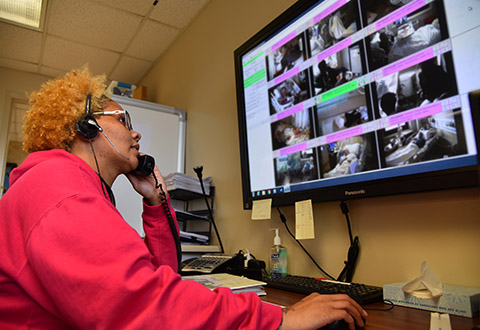Ensuring Safety From Afar

A Cincinnati VA employee monitors Veterans in the ICU via the Virtual Telesitter Solution.
Ensuring Safety From Afar: The Virtual Telesitter Solution
Joye Beth Ackerson, MSN, RN, CNOR, nurse manager, Cincinnati VAMC
According to the Institute of Healthcare Improvement, at least 30 percent of inpatient falls result in moderate to severe injuries. Of those, 6 to 44 percent involve head injuries, serious fractures, subdural hematomas and excessive bleeding. In 1 percent of falls with injury, or 11,000 times per year, the injuries result in death1.
The Cincinnati VA Medical Center has recently integrated the Virtual Telesitter Solution into their acute and critical care areas. The telesitter allows remote monitoring of up to 12 Veterans at a time and the ability to intervene instantly to prevent harm. The fixed and mobile camera units are now found in hundreds of hospitals across the United States including a number of the nation’s most prestigious and safety-conscious hospitals and systems.
Within the acute, critical care and long-term care setting, there are many Veterans at risk of hurting themselves or others. These individuals may have an increased likelihood of falling, eloping, becoming violent, pulling off lines and tubes and so on. This meant putting a trained staff person (sitter) in the room 24/7. By using the telesitter, staff can monitor multiple high-risk Veterans at the same time allowing nursing assistants to return to direct patient care activities. Not only does this decrease the cost of treating these Veterans – it is about 20 percent less than the average cost of sitters – but more importantly, the solution catches and prevents adverse events which improves patient safety, satisfaction and quality.
There are three components to the telesitter solution: technology, clinical workflow and data analytics. From the technology standpoint, the system aggregates telesitter views of at-risk Veterans allowing the observer to see anywhere in the room, including fine details such as skin color changes, shallow breathing and whether a Veteran’s pulse oximeter is still attached. The virtual monitoring technician is able to speak with the Veteran through two-way audio. If the Veteran is unresponsive to verbal direction, there is a STAT alarm that automatically cues the nursing staff to immediately go to the Veteran’s room.
The Cincinnati VA has also incorporated a wireless, hands-free, wearable, lightweight, voice-controlled clinical communication device into the workflow. This device allows broadcasting to the entire unit when a STAT or emergent event occurs. When there is a language barrier, staff can use the solution’s pre-recorded statements that come in more than 200 languages. This includes common phrases such as, “Stay in bed,” or, “I’m going to get your caregiver right away.” Finally, the system includes data analytics with a real-time dashboard that shows a variety of metrics including: number of carts in use, verbal redirections, STAT alarms, etc.
The new technology does not replace any current safety practices; it simply enhances these efforts and is another tool to provide high-quality care for Veterans. Clinicians determine whether a Veteran’s condition and risks call for using the system. Sitters are still used for Veterans who are homicidal, suicidal or severely hard of hearing. Thus far, the feedback received from Veterans and their family members has been very positive. Families feel at ease knowing someone is continuously looking after their loved one when they are most vulnerable.
Strong program leadership was instrumental to implementation. Moving to this kind of system can be a bit disruptive because it is a departure from the typical approach. So, you need to have clinical leaders whom people respect, believe in and will follow. These individuals must take responsibility for building enthusiasm and maintaining momentum, to share good catch stories, to be committed and stay involved in the process to ensure long-term success.
The use of the Virtual Telesitter Solution emphasizes the Cincinnati VA’s commitment to quality and safety for our Veterans while using innovative technology to redirect them before a fall or adverse event occurs.
References
1. Falls Prevention. Institute for Healthcare Improvement, 2017. Web. 27 July 2017. http://www.ihi.org/Topics/Falls/Pages/default.aspx.



















